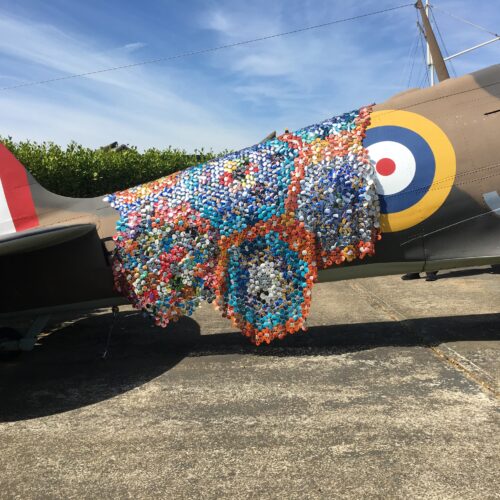
Digital Material Concepts: a collision of craft & technology

Over the last few weeks, I have been working collaboratively with Sara Robertson to develop digital material concepts for an interactive textile table runner. We have been combining our areas of responsive technology expertise for a new project: Digital Lace, which was selected for the ‘Rejuvenating Craft’ Expert Workshop, funded by the European ‘Crysalis Project’ hosted at Plymouth College of Art in May 2014. The workshop presented us with an opportunity to develop a product using responsive and digital technologies with hand craft processes. Our research interests lie in the application and aesthetic potential of smart materials and at the heart of our work is a passion for material experimentation. Sara’s background is printed textiles – she uses chromic materials and thermochromic dye systems, my background is constructed textiles – I use light-emitting properties of fibre optics and lighting systems.

One of the themes for the workshop and a global 2014/15 trend at Heimtextil (accessed April 2014) which highlighted the increasing demand for unique products utilizing novel material properties and digital making was ‘Collision’. This inspired us to think about ways we could create dynamic and unexpected visual effects within ‘a collision of craft and technology with responsive materials’. The runner will be inlayed into a simple console table and programmed to generate different colour changing and light emitting effects using digital micro controllers. It is inspired by rare, 17th century lace samplers from the National Museums’ Collection, Scotland. We were fascinated by the detailing and visual qualities which to us suggested new material and design concepts.

We also experimented with white-scattering liquid crystal dyes which are not yet commercially available. Traditional leuco thermochromic dye systems change from colour to colourless on temperature change (black to white). These liquid crystal dyes do the reverse (white to black). This offered us a completely new way of working with thermochromic materials and one that hadn’t been explored before. We were able to design with positive and negative imagery and create reversible colour-changing shifts within one print. This created the illusion of printed lace disappearing and reappearing in different phases across the piece. I am still perplexed and mesmerized by this! Have a look at our video which shows the various phases of the white-scattering liquid crystal dyes:
‘Rejuvenating Craft’ Fibre Optic Lace from Sara Robertson on Vimeo.

Although we were working from knowledge of our own materials and respective practice, we didn’t know how they would function together aesthetically. Interestingly, Sara and I have worked quite differently in this project. We normally use laser etching to treat or pattern fibre optic or thermochromic surfaces; instead we switched to hand craft processes and have used digital technology to speed up the other parts of our process which has given our materials totally new qualities.

Both the optical fibre and liquid crystal dyes are understated (plain) until they are activated through light or temperature change. We would admit that bringing these technologies together to create an interesting and responsive surface was harder than we anticipated. However, through the creative process of making, we have discovered really exciting things that we couldn’t have anticipated by this interaction of colour-change and light interplay. As textile practitioners, it is important to be reminded of this phenomenon and of the need to be flexible and spontaneous in designing with new (material) knowledge!
What kind of new processes have you used that have produced unexpected outcomes? Have you had the experience of using a new material or a combination of materials that have resulted in you doing something completely differently?







Not my field of study at all, but so interesting! Thanks for sharing!
I think this is so interesting. The interaction (quite literally ) between the user, the potential functionality and the aesthetic is fascinating. I really admire the work Sarah has already done in creating woven structures and light and this new work combining art, craft and technology is really exciting.
Sarah, Sara, I saw this and thought it might be of interest to you and others working with textiles… http://www.muskegonartmuseum.org/media-room/press-releases/339-call-for-entries-extreme-fibers-textile-icons-and-the-new-edge
fascinating…..would so love to see this with my own eyes !!